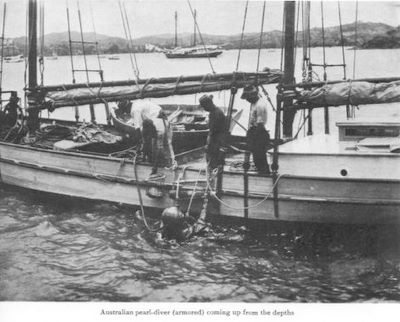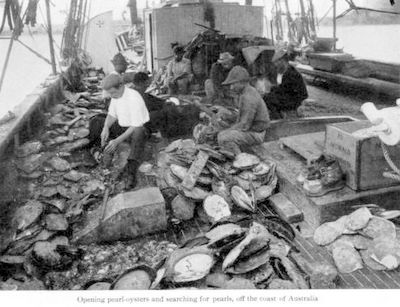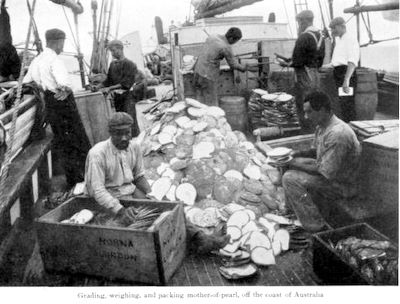|
Historic Reports of Pearl Divers in AustraliaPearl Divers in Australia were usually not white people. The following is historic information from the Kunz and Stevenson book about pearling published in 1908.  Australian Pearl Diver The small yield in Queensland in 1904 and 1905 was due largely to the extended rough weather and the accompanying thick or muddy water, which presented an obstacle to the prosecution of the work. Mr. High Milman, the government resident at Thursday Island, states that each year the beds in the more sheltered spots have been extensively fished, rendering it necessary for the fleet to go farther afield in places where the depth of the water is greater, and where the vessels are more exposed to the full force of the southeast winds which prevail for about seven months of the year, and which were unusually sever in 1905. (1) The general denudation of the beds is not the principal cause of the decreased take. An additional cause for the falling-off in 1905 was the deflection of a large percentage of the fleet to new fields of operation, 110 vessels leaving for the Aru Islands in the Arafura Sea, when the season was about half finished. For vessels using diving apparatus for the pearl divers in Australia, the season continues throughout the year, but it is frequently interrupted by storms, which may cause the boats to remain in harbor for ten days, or even two weeks at a time. The nude divers suspend work from December to March, and also during the season of gales. Each vessel is manned by a pearl diver, his attendant, and a crew of four men, who in pairs take alternate shifts at the manual pump for supplying air to the diver. The entire force of men take part in managing the vessel and in caring for the catch. The vessel is provided with full equipment and supplies of food, water, etc., to the last two or three weeks, depending on the distance of the fishing-grounds from the shore station, or the frequency of trips made by a supply vessel. Except a number of owners and their representatives, there are now very few white persons engaged as pearl divers in Australia. Even the persons in charge of the vessels are largely natives of the Pacific Islands. Owing to the hardships encountered and the small remuneration, it is difficult to secure white labor; and aliens from Japan, the Philippines, Java, Singapore, India and New Guinea, are employed as pearl divers in Australia.  Searching for Pearls in Australia
The pearl divers in Australia are of many nationalities, principally Japanese and Malays, and the former are said to be the most efficient. Previous to 1890, they were mostly whites who were pearl divers in Australia, and were paid at the rate of £40 per tons of shells; but increased competition and the influx of cheaper labor caused a considerable decrease in the rate of compensation, driving most of the white men out of employment as pearl divers in Australia. At present the Japanese almost monopolize the business of pearl divers in Australia. Of the 367 pearl divers in Australia licensed at Thursday Island in 1905, 291 were Japanese, 32 Filipinos, 21 were from Rotuma Island, 16 were Malays, and seven were of other nationalities; this shows how completely the white man has been driven out of this skilled branch of pearl divers in Australia. The oysters are so scattered that considerable walking by the pearl divers in Australia is necessary to find them. They usually lie with the shells partly open, and in grasping them the fisherman must be careful not to insert a finger within the open shell, or a very bad pinch will result. The progress of the ship must be adapted to that of the diver, and when a good clump of oysters is found it may even be desirable to anchor. If the current and wind are just right, a vessel may repeatedly drift over a bed, the diver ascending and remain on board while the vessel is retracing its course to the windward side of the reef. On new grounds, the nature of the bottom is determined by casting the lead properly tipped with soap or tallow, and the prospects for oysters thus determined without descending. During good weather and in eight or ten fathoms of water, pearl divers in Australia can work almost continually, and need not return to the surface for two hours or more; but as the depth increases, the length of time he may remain at the bottom in safety decreases almost in geometric ratio, and he comes to the surface frequently for a “blow” with helmet removed. Evidence secured by a departmental commission of the Queensland government in 1897, showed that in good weather at a depth of eight or ten fathoms, pearl divers in Australia work from sunrise to sunset, coming to the surface only a few times. In a depth of over fifteen fathoms the attendant usually has instructions not to let him remain longer than fifteen minutes at a time; yet a diver’s eagerness in working where good shell is plentiful sometimes impels him to order the attendant to disregard this rule. The very great pressure of the water—amounting to thirty-nine pounds or more to the square inch—is liable to cause paralysis, and death occasionally results. In working at a depth of twenty to twenty-five fathoms, pearl divers in Australia are rarely under water longer than half and hour altogether during the day. The greatest depth from which shell is brought appears from the same evidence to be “30 fathoms and a little over”; but at that depth—where the pressure is seventy-eight pounds to the square inch—the fisherman remains down only a few minutes at a stretch, and should be exceedingly careful.  Packing Mother of Pearl in Australia The work is injurious, and even under the best conditions the diver does not infrequently become semi-paralyzed and disqualified in a few years. Notwithstanding that the work is preformed by men in vigorous health, nearly every year there are from ten to twenty-five deaths in the Queensland fleet alone;(2) three fourths of these are due to paralysis, and most of the remaining result from suffocation, owing largely to inexperience in use of gear. From five to ten years is the usual length of a man’s diving career, although in the fleet may be found pearl divers in Australia who have been diving for twenty five years or more. On the vessels manned by Japanese, commonly several members of the crew are competent pearl divers in Australia and take a turn at the work, although only one license if secured. Such a vessel carried only one head-piece, but two otherwise complete suits, the helmet fitting either, so that as soon as one exhausted diver comes up to rest, a successor is ready to have the helmet screwed to his body-dress and descend without delay, thus saving about half an hour in the changing. The nude divers in the Australian pearl fisheries are mostly Malays and Australian aborigines. They work from dinghies operated from a vessel, each dinghy six or eight divers. The man in charge sculls against the tide to keep the boat stationary over the ground, and all the fishermen of a particular dinghy descend together for greater safety from sharks, and to cover the ground systematically. On rising, each diver swims to the boat, throws his catch over the gunwale, and climbs in to rest for a few minutes. Sometimes two or possibly three oysters may be brought up at a single descent, but a diver is doing well if he bring up on oyster in ten descents. The average daily catch of each man is probably two or three oysters, but a fisherman has been known to bring up fifty in one day. On some vessels, those who fall behind in the catch are punished by extra duty aboard ship. The pearling industry has had marked effect on the industrial and social condition of the natives of the Australian coast and the adjacent islands. Many of these natives now have boats of their own, and others seek employment on other vessels. Law and order and decent respect for property have arisen, with schools and churches. The result is all the more remarkable when is it considered that scarcely more than a generation has passed since labor among the men was unknown, the women doing all the work necessary to meet their scanty requirements. As now carried on in Australia, pearling is a hard life, the pearl divers in Australia working for two thirds of the season in a dead calm and oppressive heat, while in the remaining months they are rolling day and night. The members of the crew are not allowed ashore without a written permission from the captain of the boat, and men and luggage are searched on leaving the vessel. In addition to these objections, life on board is not unusually made intensely disagreeable by the myriads of inch-long cockroaches, which are attracted by and multiply rapidly on the shreds of muscle left on the pearl shell stored in the hold. Storm are frequent on the coast. In February, 1899, three schooners and eighty smaller vessels were wrecked, and four hundred men were drowned. 1.During the month of June, 1908, a sever storm destroyed a pearling fleet with a loss of 40 vessels and 270 lives. Special thanks to Kunz and Stevenson for their information about pearl divers in Australia in their book published in 1908. Pearl Divers Pearl Diver as reported in 1800's Quotes about Pearl Diving Times and Depths of Pearl Divers Diving Dangers |











